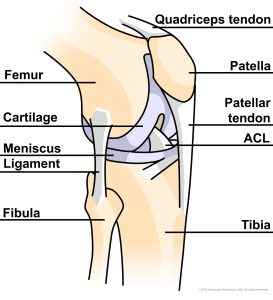
Knee pain can occur for many reasons. You may experience knee pain in the area above the knee, along the sides of the knee, behind the knee, or under the kneecap (patella). The pain can originate either from the bones of the knee joint, or from the ligaments, tendons, and cartilage of the knee. It is important to consult a knee specialist to get an accurate diagnosis and the appropriate treatment.
What do I need to know about knee anatomy?
The knee is a specialized hinge joint formed by the lower end of the thigh bone (distal femur) and the top of the shin bone (proximal tibia, or “tibial plateau”). The distal femur has two “condyles”, one medial (inside of the knee) and one lateral (outside of the knee). The kneecap (patella) is a small but important bone between the patellar tendon and the quadriceps muscle tendon. It acts like a pulley, articulating with the central surface of the distal femur (the trochlea) and improving your ability to straighten (extend) the knee joint.

Cartilage cushions all of the bone surfaces within the knee and reduces friction. The two C-shaped menisci are located between the tibia and each femoral condyle and serve as shock absorbers. Each meniscus is secured to the tibia and the adjacent joint capsule. The knee is encased in a sheath (capsule) that is lined with “synovium”, which secretes a nutrient-rich fluid (synovial fluid). Synovial fluid nourishes and lubricates the joint. When the lining of the knee becomes inflamed and irritated it produces extra fluid that results in swelling of the knee joint.
There are several important ligaments within and around the knee that stabilize the joint. The ACL (anterior cruciate ligament) keeps the shin bone (tibia) from sliding too far forward (anterior) relative to the thighbone (femur). The PCL (posterior cruciate ligament) keeps the tibia from sliding too far backward (posterior). The MCL (medial collateral ligament) stabilizes the inner aspect (medial side) of the knee, connecting the femur and tibia, while the LCL (lateral collateral ligament) stabilizes the outside of the knee, connecting the femur and the fibula.
Although the inside of the knee joint is one continuous space, it is often conceptualized as having three “compartments”: medial, lateral, and patellofemoral. The medial compartment is comprised of the medial femoral condyle, the medial tibial plateau, and the medial meniscus. The lateral compartment is comprised of the lateral femoral condyle, the lateral tibial plateau, and the lateral meniscus. The patellofemoral compartment includes the femoral trochlea, between the condyles, and the patella. Disease within the knee can affect one, two, or all three compartments.
What causes knee pain?
The knees are subjected to a lot of wear and tear. While walking, each knee experiences 3 to 4 times your body weight. In some patients, up to 6 times their body weight is borne by each knee. Injuries and repetitive strain are common causes of knee pain, but degenerative diseases that cause damage to cartilage and bone are also possible factors leading to chronic knee pain.
Some common causes of knee pain include:
- Knee arthritis, including osteoarthritis and inflammatory arthritis
- Meniscus injuries
- Loose cartilage
- Dislocated kneecap (patellar instability)
- Bursitis
- Tendinitis
- Overuse injuries, such as iliotibial band syndrome (ITBS) and patellofemoral pain syndrome (PFPS) / runner’s knee
- Sprained knee ligament
- Previous knee condition or injury that did not heal properly
- Malalignment of the leg
- Excess weight
When should I see a doctor for knee pain?
If the knee pain is minor, nonsurgical treatments may be successful at relieving your symptoms. These include rest, and icing or heating the painful area to reduce discomfort. However, if knee pain persists or becomes more severe, patients should make an appointment with an orthopedic knee specialist. In particular, if knee pain interferes with your daily life, work or recreational activities, wakes you from sleep, or requires prescription pain medication, you should not delay seeing a knee surgeon.
Some knee pain symptoms may warrant immediate medical assistance. A consultation may be recommended immediately if you have any of the following knee pain symptoms:
- Extreme pain in the knee joint
- Inability to stand or put pressure on the knee
- Significant swelling
- Redness or discoloration
- Tenderness that won’t go away
- Fever or other symptoms of infection
- Warmth around the knee joint that doesn’t go away
How will Dr. McLawhorn diagnosis my knee condition?
Dr. McLawhorn prefers to begin your evaluation by taking a detailed history, including your description of your knee pain along with your general health history. Next, he performs a physical exam, during which he will assess your walking, range of motion, and strength around the knee. X-rays are important part of your evaluation to look at the status of your knee joint. X-rays of other relevant areas, such as the pelvis, may be ordered if necessary for an accurate diagnosis. MRI is useful when there is further question about the health of the bone, cartilage, menisci, ligaments, tendons, or muscles around the knee. CT is ordered selectively for patients requiring certain types of knee surgery. Blood work or injections into the hip, knee, or spine may be necessary for diagnosis in rare circumstances.
After Dr. McLawhorn makes the diagnosis, he will recommend the best treatment option to suit your needs and expectations.
There are many possible causes for knee pain, which can lead to more serious problems if left untreated. It is important to seek advice from an orthopedic knee specialist to accurately diagnose and treat your knee pain. Dr. McLawhorn is an orthopedic surgeon at Hospital for Special Surgery, specializing in hip and knee reconstruction and replacement. He sees patients at locations in New York and Connecticut. To learn more, call 212-606-1065 (NYC) or 203-705-2113 (CT) today or schedule an appointment by using the form on this page.
Learn more about knee pain, conditions, and treatments at hss.edu


